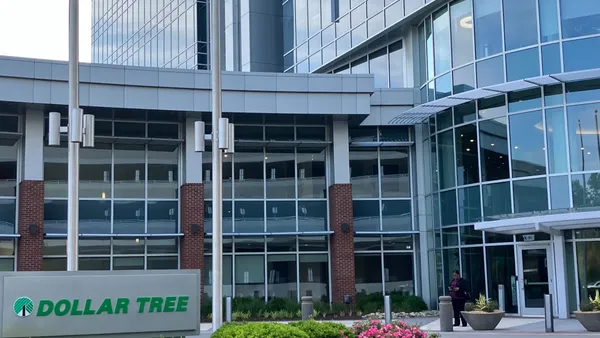If you know anyone who works in demand forecasting or inventory management for a retailer, they could maybe use a hug.
These were always difficult jobs, based in no small part on the vagaries of consumers tastes, trends and various intersecting markets and economies. The pandemic era has thrown several new layers of difficulty in planning and purchasing inventory. From panic buying to supply shortfalls to historic inflation spikes, the intensity by which the environment can change is matched only by the speed of that change.
Target’s shocker earlier in June highlighted how quickly the world changes. Just weeks after cutting its profit expectations for the second quarter, the retailer cut them again, dramatically. Just as importantly, the retailer signaled it was moving to clear inventory through markdowns and other measures, and would be canceling orders.
It was a sign of the speed and severity of consumer changes and cost inflation. It also portended rocky days ahead for the industry as it prepares for the all-important holiday season. Retailers, brands, wholesalers and other industry players are trying to match inventory with consumer demand — whatever that will be for the season.
“They're guessing. They're all guessing. And any one of them that tells you they're not guessing, they're lying, because they don’t know,” John McQuiston, managing director and global head of originations, receivables and trade finance with Wells Fargo, told Retail Dive in an interview. “The demand levels are entirely unpredictable. Consumer behavior is unpredictable. … This is a bit of a crystal ball Christmas.”
‘Rapid revisions’ at Target
While some analysts called out Target for the planning miss, the announcement was illustrative of several things going on in this particular moment in retail.
Baked into Target’s description of what it was doing and why was a kind of whiplash. Customers changed their purchasing behaviors much more quickly than the company anticipated, whether through bad luck, poor planning or some combination of the two.
From Target’s past earnings call, as well as those of Walmart and other retailers, it’s clear that consumers are reacting to price inflation, particularly in food and fuel, the latter of which has skyrocketed since Russia (a major oil producer) invaded Ukraine and has exacerbated already elevated supply chain costs.
“They’re guessing. They’re all guessing. And any one of them that tells you they’re not guessing, they’re lying, because they don’t know.”

John McQuiston
Managing Director & Global Head of Originations, Receivables & Trade Finance, Wells Fargo
Target’s post-earnings announcement was a sign of just how quickly consumers were changing. The retailer said at the time that it was making “rapid revisions to sales forecasts, promotional plans and cost expectations by category.” Specifically, the company cut its forecasts for discretionary categories — calling out home goods by name — while expecting strength in food, household essentials and beauty.
Following Target’s announcement, Bill Kirk, managing director with MKM Partners, said in a research note that the analyst team observed “strong discounting” in a store visit to Target in discretionary sections of the store.
And while Target said it is clearing inventory to help foster top-line growth — by pivoting to better-selling (if lower-margin) products — the move is not without risks beyond the profit hit.
“We worry that large discounts could damage Target's brand image: 1) part of the apparel department looked like a Ross ... store; 2) the electronics department looked like Black Friday; and 3) outdoor goods looked like it was Winter,” Kirk said in the note. “We worry that even after inventory clears, some impact could remain.”
Mismatches in supply and demand, and sales and inventory levels, extend far beyond Target and cover many if not most discretionary categories. As one example, HSBC analysts said in a mid-June note they were “[b]racing for another lap of complexity” in the sporting goods sector.
The “[b]iggest risk in our view is the sector moving from inventory shortages last year to a glut as early as H2 this year,” the analysts said. “With tight inventories, the sector enjoyed some gross margin support (more full-price sales); with supply chains functioning a lot more efficiently now and possibly some over-ordering, we could soon be in a situation in which inventories are larger than what the market can absorb.”
BTIG analysts Camilo Lyon and Mackenzie Boydston said in a research note that they heard from retail contacts that Nike was “surprising” wholesale partners with more “at-once” orders potentially due to slowing DTC sales, thus “creating a need to place late-arriving inventory.”
The analysts said the move “is surprising to us since at-once orders have been relatively rare in this supply-constrained, COVID environment as [Nike] has struggled to get back into a normalized delivery cadence.” But they also noted that “not all is dire, as retailers that have been starved for inventory are getting it, and seemingly selling through it.”
‘Cancellations, delays and markdowns’
All of this shows how an adaptation to one extreme circumstance suddenly became a disadvantage. “What happened is that the retailers started to buy a lot more in anticipation of the issues of getting goods and bringing them on shore,” Joel Wolitzer, senior vice president and business development officer with Rosenthal & Rosenthal, said in an interview with Retail Dive. “And so they were trying to backfill to compensate for the supply chain issues at the height of the pandemic. Now they have a lot of inventory that’s not moving as quickly as they would have liked.”
Importers that Rosenthal & Rosenthal works with “are seeing cancellations, delays and markdowns and deductions that the retailers seem to be taking, because of this backlog,” Wolitzer said.
Prediction hiccups have become endemic with the pandemic. “Retailers, right at the start of the pandemic, marked everything down because they all thought they'd be fighting off bankruptcy,” Wells Fargo’s McQuiston said. “The government then sends multi-$1,000 checks to the entire American population unexpectedly. And everybody goes out and shops and finds the stores are empty because all the merchandise has been either sent off to consolidators, or marked down and sold.”
That was early in the pandemic. Today, McQuiston noted, billions of dollars in merchandise is sitting on boats waiting to be unloaded into warehouses and go on to shelves, while at the same time “the consumer has been tapped.” Again, prices for daily life needs — food and gasoline — are putting pressure on the vast majority of consumers who aren’t wealthy. (The wealthy, as always, have a buffer against economic travails, as does the luxury sector.)
There’s another factor affecting discretionary spending along with inflation, again related to the pandemic. David Silverman, senior director at Fitch Ratings, said in emailed comments following the May retail sales figures that they showed “consumers are less interested in buying more things and instead are focusing their attention on travel, entertainment, and other services.”
Some have called out retailers for not being ready for any of these various factors. “[R]etailers seemed to have taken an approach of full-bore for pandemic habits until they saw real evidence that the behavior was shifting — and, for inventory management, that’s way too late,” Nikki Baird, vice president of strategy for retail technology company Aptos, said in emailed comments. “You can’t stop a supply chain on a dime, as we already learned during the pandemic.”
All that said, the attention to inventories may be overstating the issue. Jason Miller, associate professor of logistics at Michigan State University, analyzed Q1 data for six major retailers who are also major importers: Walmart, Target, Home Depot, Lowe’s, Dollar Tree and Costco. With the exception of Costco, the days to turn inventory in Q1 this year increased over 2021 and 2019 by varying degrees. But, Miller said by email that the increases “aren't suggesting that these retailers will need to suddenly curtail a large percentage of their orders.”
Miller added, “My conclusion looking at this is that while we will see retailers be more deliberate in their ordering over the coming months, we are unlikely to see a sudden sharp drop in imports.”
But how big is the inventory decline, really?
With all that in mind, the holidays are going to be complicated, to say the least.
Asked how retailers are planning for holiday inventory, McQuiston said they were doing so “with a great deal of emotion.” Once again, the retail world is headed into a holiday season defined by — to use a word that has been overused but unavoidable since the pandemic began — uncertainty. A safe bet, with the understanding that everything could quickly turn, is that consumer momentum won’t be what it was last holiday cycle.
Fitch expects heightened promotions through the summer as retailers clear excess inventory. Silverman noted that “reduced inventory orders for the back half of the year could help overall industry health while easing some supply chain concerns.”
For now, retail products are still shipping, Target’s cancelations notwithstanding. Imports in April remained at near record high volumes, according to tracking by the National Retail Federation and Hackett Associates.
“We’re in for a busy summer at the ports,” Jonathan Gold, NRF’s vice president for supply chain and customs policy, said in a June press release. “Back-to-school supplies are already arriving, and holiday merchandise will be right behind them.”
Government data pulled by Michigan State’s Miller also shows import levels well above 2019 levels in April (by 37%, according to Miller’s analysis). “What I want to emphasize is that there is no precedence beyond a monumental economic calamity (e.g., the original COVID shutdowns, the Great Recession) for sharp drops in volumes,” Miller said.
But whether retailers will be able to sell all the goods coming in today is the big question. And with freight, fuel and labor costs elevated for retailers, the pressure is on those doing the purchasing and inventory planning in a market that continues to defy prediction.
“There’s a lot of noise out there with inflation and rising [interest] rates,” Wolitzer said. “If retailers are able to flush out some of the non-performing goods, they’ll make room for strong purchases for the holiday season. But there’s only so much room on the floor and in their warehouses to take merchandise in. Which is why importers are facing delays or cancellations.”
























